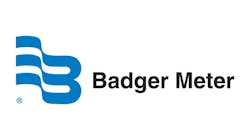Metering impacts every aspect of a water utility’s operations—from water usage and conservation to utility personnel to customer service. W&WD Associate Editor Amy McIntosh asked John Fillinger, director of utility marketing for Badger Meter, about recent trends and emerging technologies in today’s metering environment.
Amy McIntosh: What are some advances you have seen in metering technology so far this year?
John Fillinger: There have been four major changes in the area of metering technology. First has been the acceptance and deployment of smart meters with no moving parts. These meters provide utilities with a great option to accurately measure a broader range of low flows and to extend meter accuracies over the life of the meter to help make water visible in all utility applications.
The second major change has been the deployment of advanced metering analytics (AMA) systems. While traditional advanced metering infrastructure (AMI) systems provide reading data and improvements to utility meter reading efficiency, AMA systems are more encompassing. AMA systems improve the entire utility operation by transitioning reading data into proactive intelligence to help utility personnel make informed decisions about maintaining their system.
The third new innovation is the deployment of managed solutions. In the past, utilities that deployed AMI systems were forced into accepting greater responsibility for managing and maintaining their system. Through innovative managed solution approaches, utilities are able to deploy systems more quickly and reduce upfront costs by incorporating a “pay-as-you-go” approach to deployment.
The final innovation in metering technology is the release of a cellular endpoint for water utilities. While gas and electric utilities have been able to use cellular technology for the past several years, the technology has [only] recently been introduced to water utilities. Cellular endpoints are a great option for utilities because they eliminate the need for installing and maintaining gateways and use the same reliable and secure network used each and every day by our favorite smartphones and tablets.
McIntosh: What are some current metering trends?
Fillinger: Seeing the need for better customer service, increased analytics reporting and more efficient operations, utilities are turning to end-to-end, managed solutions to help meet their meter data management (MDM) needs. In a provider-
managed, cloud-based system, the solutions provider takes charge of system operation and maintenance beyond the meters and meter communications endpoints. The managed solution model provides a flexible approach that reduces the resources needed to operate and maintain the meter reading system, freeing personnel to support other critical areas of operations.
Web-based software services are key components of many managed solution models. Cloud-based software can bring rapid and diverse changes in how utilities operate and use data. Cloud computing can be a viable alternative to investing in server-based MDM systems.
McIntosh: How can a metering system help a utility meet its water management initiatives?
Fillinger: Because various utilities have different initiatives and goals, the most important benefit an AMA solution can provide won’t be the same for every utility. Commonly, the greatest benefit in adopting AMA is a reduction in operating costs. For some, the most important benefit will be in finding and fixing leaks to prevent the loss of water and revenue. For others, it may be a reduction in customer billing disputes. Still others may find that aiding their customers in water conservation efforts is their greatest benefit.
McIntosh: What are your predictions for metering technology for the remainder of the year?
Fillinger: Advances in technology mean water utilities can begin to enjoy all the benefits of AMI and AMA without previous operational and technology concerns. With implementation and management barriers removed, utilities can use these advances to provide greater visibility into water usage and better management of the water system, while improving customer service. Most importantly, today’s solutions ensure that the decisions utilities make now will pay dividends well into the future. Going forward, both utility and end water consumers will start to benefit from the deployment of AMA technology and managed solutions. Since data are already available in a cloud environment, sharing the data with end consumers allows them to make informed decisions about when and how to use water. Whether people live in an area with an abundance or a shortage of water, we all need to have access to appropriate information to make educated decisions.
Download: Here


